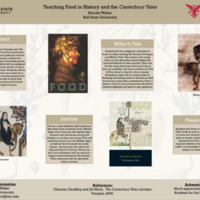Browse Exhibits (109 total)
Briana Halloran | Postpartum depression and preconception vitamin supplementation: An analysis of the Pregnancy Risk Assessment Monitoring System (PRAMS), 2016-2018

Postpartum depression (PPD), a mood disorder with a relatively unknown cause, affects around 1 in 8 women in the United States. Micronutrient levels may contribute to the pathophysiology of mood disorders and depression. This analysis aimed to examine the relationship between the intake of preconception vitamin supplements and the development of PPD using the Pregnancy Risk Assessment Monitoring System (PRAMS). The results of this analysis will better prepare healthcare workers, including dietitians, to educate women during the preconception period on the benefits of vitamin supplementation.
Faculty Mentor: Mengxi Zhang
Department of Nutrition and Health Sciences
Graduate Student
Brooke Walter | Chaucer & Food

This project allows for students to be able to use their knowledge in other subjects as well as be able to argue their point by using facts which will always be helpful. The objective of this project is for students to be able to figure out new perspectives historically through methods not used before by looking at literature at the time nd how food is being portrayed. Students after reading will then research their character that they were assigned and determine whether their interaction of food portrayed in the book is accurate. This is great for students to be able to practice multiple skills in one lesson as well as be able to use their skills in multiple subjects being taught.
Faculty Mentor: Alexander Kaufman
Department of History
Undergraduate
Honors College
Brooklyn Boatright | Nature, Timing, and Tectonic Implications of Crystallization and Metamorphic Phases of Leucogranites in the Mt. Everest Region, Nepal, Using Zircon U-Pb Geochronology

Leucogranites are an igneous granitic rock with very few dark minerals. They are a significant characteristic of the Himalayan mountains and located throughout, but their formation history and evolution in the Himalayan region are understudied and unclear. Himalayan leucogranites contain mineral geochronometers, which selectively incorporate radioactive isotopes during formation, and can be dated using the known half-life of their isotopes. Zircon is one mineral geochronometer that contains three unique decay series collectively known as the uranium/lead (U/Pb) system. These isotopes can be dated, then checked against one another to determine the accuracy and precision of resultant age dates. Similarly, the depletion or enrichment of light rare-earth elements (LREEs) and heavy rare-earth elements (HREEs) has geologic implications: they may indicate the mode of magma generation and/or determine a rock’s mineral assemblage.
The Himalayan leucogranites’ age dates will determine when the parent magma crystallized, give insight into local fault movement timing, and clarify the number of metamorphic phases the leucogranites underwent. Additionally, further implications include: broadening geologic literature regarding mountain evolution following continental collision, which can be used globally to understand other mountain-building events; explaining the process of deep subsurface magma generation; and ascertaining the probability of viable ore deposits associated with leucogranites. If the presence of ore and rare-metal mineral deposits are confirmed, they may stimulate the local economy by providing resources for metal-workers, miners, and artisans. This study aims to answer three questions regarding the Himalayan leucogranites’ formation and evolution:
- What is the crystallization age of the Mt. Everest region leucogranites?
- How many metamorphic phases did the leucogranites undergo?
- Can the age dates and trace/rare-earth element (t/REE) geochemistry be used to:
- Constrain local fault movement timing
- Determine the probability of economic ore and rare-metal mineral deposits associated with Himalayan leucogranites?
Eight leucogranite samples were collected May-June 2018 along the Everest Base Camp trekking path. National Petrographic Laboratory made thin sections of six samples in December 2020. Petrographic analysis began in January 2021 to identify mineral assemblages and metamorphic features and will continue to October 2021. All eight samples have been crushed according to standard mineral separation practices and four were sent to the Arizona LaserChron Center (ALC) in February 2021 to finalize mineral separation. LA-ICP-MS and SHRIMP will be utilized to determine the t/REE composition and zircon age of the leucogranites. Plans have been made to travel directly to ALC in May 2021 to conduct instrument analyses. Expected results are Miocene-age zircon dates, 2-3 metamorphic phases, a range of timing for the South Tibetan Detachment's motion of about 20 Ma, and the presence of rare-metal minerals apparent in thin section.
Faculty Mentor: Dr. Kirsten Nicholson
Secondary Mentors: Dr. Jeff Grigsby and Dr. Klaus Neumann
Department of Environment, Geology, and Natural Resources
Graduate Student
Bryce Kramer | Electron Transport and Conductivity in DNA

As technology pushes computer processors to become smaller and denser, processor chip manufacturers are trying to find ways to make transistors smaller and smaller. However, current transistor designs are becoming increasingly difficult to squeeze into smaller and smaller areas without compromising the integrity of the transistors. As a result, a new candidate has gained attention for its potential uses in many areas, especially nanotechnology: Deoxyribonucleic acid (DNA).
DNA has many properties that make it a potential candidate for nanotechnology including its ability to self-assemble, which can allow easier fabrication on the nano-scale. However, studies have also shown DNA to have insulating, conducting, semi-conducting, and superconducting properties given different conditions.
These findings, as well as other known factors about DNA, are leading researchers to study DNA's potential in different aspects of nanotechnology, such as potentially being a semiconductor within a nanoscale, self-assembling transistor. This project will investigate electron transport and conductivity in DNA molecules.
Faculty Mentor: Dr. Yong Joe
Department of Physics and Astronomy
Undergraduate
Bryce Woody, Zach Hoeing, Justin Russell, Jacob Davis, Corbin Curnutt | Full Court Analytics

A subscription-based analytics tool for basketball coaches that provides insight on the efficiency of their team from season performance to game performance. The tool also includes advanced stat tracking, line-up proficiencies, and play-by-play tracking.
Faculty Mentor: Dr. Huseyin Ergin
Department of Computer Science
Undergraduate
Cailon Nicoson | Between a Rock and a Hard Place: How Transportation into Stories Representing Protagonist’s Criminal Behavior Affects Reader’s Empathy
Previous research has found that reading fictional stories can increase empathy in individuals who read it (Bal & Vetkamp, 2013; Dodell-Feder & Tamir, 2018; Kaufman & Libby, 2012; Stansfield & Bune, 2014). One important factor that contributes to fiction’s potential empathy-teaching effect is the concept of transportation; transportation is the reader’s ability to “transport” themselves into the story, particularly in the shoes of the protagonist, to better understand how they themselves would react in the character’s situations (Bal & Vetkamp, 2012). The current study analyzed the effect transportation into a story in which the protagonist engaged in a criminal act (e.g., substance abuse and theft) could have on the reader. Participants were asked to read two texts each; one arranged as a list of facts and the second being an emotionally-charged, third-person perspective of either the protagonist’s engagement in substance abuse or theft. One group received one compilation of facts regarding the protagonist’s engagement in either substance abuse or theft and one emotionally-charged account of the protagonist’s engagement in the offense not represented in the first story.
Faculty Mentor: Dr. Kristin Ritchey and Dr. Thomas Holtgraves
Department of Psychological Sciences and Criminal Justice/Criminology
Undergraduate
Honors College
Caitie Flower | Evaluating a Course for Training Undergraduate Teaching Assistants
An 8-week course was developed to train undergraduate teaching assistants on a variety of ethical, professional, and practical topics. One semester of pre-and post-test data was collected to measure increases in students’ knowledge, skills, and consideration of a teaching-related career. Preliminary results indicate some increases in students’ skills across the semester.
Faculty Mentor: Dr. Kristin Ritchey
Department of Psychological Science
Undergraduate
Camryn Zeller | More Knowledge and Less Sleep: Sleep Patterns in Nursing Students
There is precedent that nurses and students have unhealthy sleep patterns and sleep hygiene. The purpose of current research is to determine if a student’s year in school (i.e., first year, second year, etc.) is related to any unhealthy sleep patterns or hygiene they may present. A survey including the PSQI, the Sleep Hygiene Knowledge subsection of the SHAPS, and a survey of demographics screening out those with disordered sleep will be used to determine sleep quantity, quality, and hygiene knowledge patterns across cohorts. If there is evidence of poor sleep quality, quantity, or hygiene knowledge in this population, it indicates that more research should be done on how severe these variables may impact performance of nursing students. Highlighting specific years or times where these unhealthy practices may be more prevalent could help determine when sleep education should be utilized to help the population build healthy sleep habits before going into the nursing field. It will also provide data for future studies on what patterns of sleep to expect in this population.
Faculty Mentor: Dr. Thomas Holtgraves
Psychological Science
Graduate
Carly Lucas | The Dance-Language Conflict

"The Dance-Language Conflict" is a creative research project exploring how dance is and is not used as a "language," ultimately making the argument that it is not one. The original presentation was paired with the results of a movement experiment where participants were asked to attempt to translate dance. This exhibit is composed of a written summary of the presentation, in addition to clips from the original film and digital evidence from the movement experiment.
Faculty Mentor: Jenn Meckley
Department of Theatre and Dance
Undergraduate
Cassandra Zeigler | Emotion Dysregulation, Attachment Insecurity, and Perceptions of Justice and Fairness Among Emerging Adults in Romantic Relationships
Attachment styles in adulthood describe individual approaches to interacting and behaving interpersonally, or patterns of secure and insecure attachment orientations in romantic relationships (Bowlby, 1969). While previous research has demonstrated that insecure attachment styles are related to difficulties with regulating emotions (Gross & John, 2003; Owens et al., 2018; Winterheld, 2016), present literature has not addressed these associations in both members of relationship dyads using counterbalanced self-report measures. The current study will examine the associations between insecure attachment styles and emotion dysregulation among couples in romantic relationships. This study will employ a cross-sectional survey design with a sample of approximately 84 dyads of college students to obtain a medium effect size (r = .30) and a power level of 80% (Faul et al., 2007). It is hypothesized that individuals with lower levels of anxious and avoidant attachment tendencies will also report fewer difficulties with emotion regulation strategies, and couples are expected to report a high degree of similarity on both measures relative to each other. These anticipated findings would align with the similarity hypothesis that individuals choose dating partners with the same attachment style as themselves (Strauss et al., 2012) and the concept of assortative mating, that individuals seek partners with similar traits to their own (Macrae et al., 2008). Results will be analyzed with a series of Pearson’s correlation coefficient (r) tests to examine associations between variables at the individual level and to determine the degree of nonindependence, or the extent of similarity between the two members of the dyadic unit.
Faculty Mentor: Thomas Holtgraves
Psychological Sciences
Graduate
